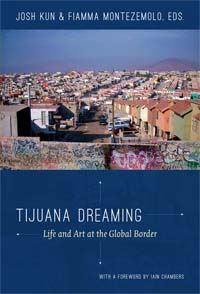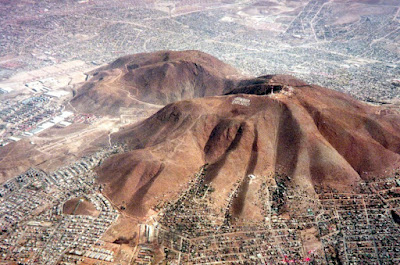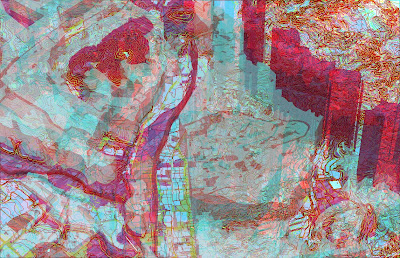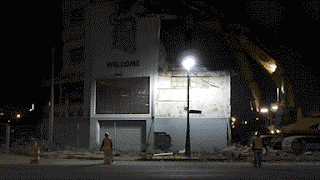Category: Uncategorized

Rene Peralta forma parte de este libro como ensayista y tambien con la fotografia de la portada…coming soon!
An essay by Rene Peralta is part of the book “Tijuana Dreaming: Life and Art at the Global Border” by Josh Kun and Fiamma Montezemolo. One of Peralta’s photograph of East Tijuana was chosen to illustrate the front cover.
Rene Peralta de Generica Arquitectura + Diseño Urbano formo parte del proyecto fotografico titulado La Frontera del fotografo aleman radicado en NY – Stefan Falke
Para ver todas las imágenes click AQUI
Un video que realizaron los alumnos de Woodbury después de su visita a Guadalajara. Taller de diseño urbano de 8tvo Semestre, Profesores: Jose Parral y Rene Peralta
A video by Woodbury students after their visit to Guadalajara Mexico. 4th year Urban Design Studio. Professors: Jose Parral and Rene Peralta
GDL from OMAR KAKAR on Vimeo.
GDL VIDEO
Here is the article on the destruction of the TJ Police and Fire Station I wrote for the SD Reader
We went one day about a month ago/ to have a little fun in Mexico.
We ended up in a gambling spot/ where the liquor flowed and the dice were hot
So here we are in the Tijuana jail/ Ain’t got no friends to go our bail
So here we’ll stay ‘cause we can’t pay/ Just send our mail to the Tijuana jail
— “Tijuana Jail,” by the Kingston Trio
La Ocho
It has been over a month since the Tijuana police station (also known as “La Ocho”), located on the corner of Eighth Street and Avenida Constitución in downtown Tijuana, met its demise. On December 30, the mayor’s office ordered the destruction of the infamous station and jail. A few days earlier, the city council had voted to sell the public plot in a private auction.
At nightfall, the bulldozers began to tear down the walls. Early the next morning, onlookers began to gather, some with tears in their eyes, others with signs demonstrating their angst against the act of urbicide they where witnessing. But the demolition continued and did not stop with the police station; they cleared the entire ¾-acre site, including Estación de Bomberos #1, the city’s first fire station. The fire station had been built in the ’60s and had all the necessities firemen needed to do their job well — it even had a covered basketball court on its second level.
In less than a week, the two historic buildings were leveled and a pile of rubble stands as testimony to the hegemony of Tijuana’s National City–born mayor, Carlos Bustamante.
When is a Building More Than a Building?
Sometimes when we think of preserving structures, “time” is reduced solely to dating buildings. The Tijuana jail and fire station were built in the 1960s, but this fact defines only part of its historical legacy. The mayor of Tijuana mentioned that his decision to demolish the buildings was because they were old and had structural damage, a questionable assertion (no documents of the structural survey were ever published). Yet, the mayor didn’t consider that collective memory also plays an important role in the legitimization of a building as a historical artifact.
Bustamante also added that the history of the building was evil and “tiene muy malas vibras” (“it has bad vibes”); therefore, its continued existence would only serve to promote the negative image of the city…as if the act of demolishing the buildings eliminates the negative image of a shady government and its notorious under-the-table deals.
What are the costs of the demolition of these structures, and are these costs unavoidable for the progress of Tijuana? So far, the end does not justify the means: the fire-department staff and equipment sit on an empty lot with a trailer as their office and await a new fire station. The police department had the desire to make a museum of the old station. Not only did the fire and police departments demonstrate their displeasure with the demolition, but a few groups picketed the site.
One of the loudest voices against the demolition and selling of the plot came from “Todo Somos Tijuana,” a preservationist group consisting of intellectuals and artists whose main demand is to prevent the selling of the plot to a private entity and to persuade the city to use the space for cultural, artistic, and educational functions.
Maria Curry, an architect and expert in historic preservation (and a current member of the San Diego Historical Resources Board), posted the following on Facebook: “Unfortunately preserving historic buildings is not part of the preservation policies in Tijuana, which is a mistake because old buildings can bring many economic and social benefits if they are properly used and integrated to urban planning….”
A member of Tijuana’s Professional College of Architects, Diana Nieto, used her blog to express that adaptive reuse might have been a better future for both structures. Nieto wrote that many countries, including Mexico, have readapted decommissioned jails to function as public and cultural institutions; for example, Mexico City’s Lecumberri Penitentiary, also known as the “Black Palace,” now houses the national archives. The building is surrounded by a large public park and research facilities. Nieto’s list of adaptive-reuse examples includes other penitentiary buildings in Mexico.
There is no doubt (except in the TJ mayor’s office) that cities need old buildings as much as we need new ones. Jane Jacobs wrote in her book The Death and Life of Great American Cities, “Cities need old buildings so badly it is probably impossible for vigorous streets and districts to grow without them. By old buildings I mean not museum-piece old buildings, not old buildings in an excellent and expensive state of rehabilitation — although these make fine ingredients — but also a good lot of plain, ordinary, low-value old buildings, including some rundown old buildings.”
The buildings of Tijuana are exactly what Jacobs describes: ordinary, low-value buildings of pseudo-architectural styles from California Revival, Neoclassical, and early Modernist eras. Their primary value is in the role they play as artifacts of memory and their place as part of a greater whole that is downtown Tijuana and its original grid of 1889. Buildings like La Ocho fit well within the urban fabric of downtown.
It’s Only Natural
“Civilised life, you know, is based on a huge number of illusions in which we all collaborate willingly. The trouble is we forget after a while that they are illusions and we are deeply shocked when reality is torn down around us.” — J.G. Ballard
It seems that most tijuanenses are not interested in going out to defend public space. For some, it’s hard enough to deal with their daily existence. For the middle and upper classes, why would they worry? When things get dirty they can go to San Diego.
Dr. Tito Alegría, an urbanist at El Colegio de la Frontera Norte, a think tank on border issues, mentions that Tijuana city government has had a long history of selling of public land to obtain revenue. Even when the population is invited to participate in the decision-making process of city-improvement programs, they don’t participate. In 1994, the city established PAU, “Plan de Activación Urbana” (“Urban Activation Plan”) and, according to Dr. Alegría, only 5 percent of the population participated in the decision-making process. “Therefore, the dismantling of the police station and selling of the property is natural procedure for the city,” he says.
To be fair, recently we saw more preservationist groups organize to defend public space, such as the group that camped in the Benito Juárez Park to stop the construction of a large concrete square plaza (known as Zocalo 11 de Julio) by private entities. Yet, these groups are small and lack credibility with the rest of the population, even if they mean well. Recently, Mayor Bustamante evacuated the occupying group, and now the future of the park and its public space are uncertain.
Tijuana is lacking a cohesive social culture, one that defends public space and its right to shape the city’s future. Currently, we are witnessing a revival of certain parts of the city and a gradual economic growth in the service sector. In the past five years, we have seen the resurrection of the nightlife in downtown Tijuana. Our middle class that fled the city during the past three years has returned from San Diego. Yet, our understanding and desire of public space is still just a vision that we find difficult to grasp or defend. I hope that soon we will have had enough of “the business as usual” politics and, like in J.G. Ballard’s novel Millennium People, we will at least aspire to be like every obedient professional and arrive punctually for our appointment with a revolution.
La Ocho
REACTIVANDO ESPACIOS / HECTOR SANTILLAN M. from wimerf on Vimeo.
Interesante el video y la idea de reactivar los callejones perdidos por una gran caída economica que se fue dando hasta que la mayoría de los comercios de esta zona cerraron. Sin embargo hay algunos artistas y comerciantes que intentan rehabilitar estos callejones aprovechando las rentas económicas y abriendo su talleres de producción artistica.
Sin embargo la cuestión del renacimiento de la Avenida Revolución, donde se ubican la mayoría de estos callejones, va ser a consecuencia de la creación de nuevos consumidores. Para esto se necesita pensar en un plan estratégico para toda la zona centro con proyectos que incluyan vivienda de clase media. Al volver la vivienda a la zona se genera una masa critica de consumidores con buen nivel adquisitivo, que después necesitaran de otros servicios y productos que podrían ser instalados en las diferentes zonas del centro, incluyendo la creación de una zona cultural y gastronomica a lo largo de la Avenida Revolución y pasajes. No hay vuelta de hoja, no se puede iniciar un por La Avenida Revolución! Pero enhorabuena por el video!
Mexicano dirigirá maestría enfocada en retos arquitectónicos de la fronteraPor Agencia EFE – hace 6 días San Diego, 1 feb (EFE).-

Ricardo Dorantes
Ciudad de México (7 febrero 2012).- La Universidad de Woodbury en San Diego California impartirá una maestría que especialice a los estudiantes en los retos, perspectivas y oportunidades que envuelven a la arquitectura fronteriza.
El mexicano René Peralta, director de este posgrado, comentó que se trata de descifrar una realidad más cercana que la de la arquitectura de acelerado desarrollo como la de China o Korea y que la de zonas multimillonarias específicas como Dubai o Qatar.
“Veíamos que las condiciones que se presentan en Latinoamérica, iniciando por Tijuana, eran los retos que enfrentan muchas ciudades fuera del mainstream urbano. La gran parte de la población mundial ya vive en ciudades y muchos de ellos lo hacen en zonas periféricas e informales; creemos que este fenómeno sólo seguirá aumentando y por eso iniciamos con proyectos de investigación en esta zona fronteriza”, señaló Peralta en entrevista.
Algunas de las condiciones que caracterizan al territorio tijuanense, dice Peralta, como la diversidad y enfrentamiento cultural, territorios en disputa, alto flujo migratorio y aspectos paradójicos, coinciden con otras ciudades latinoamericanas a pesar de que no sean éstas parte de una frontera.
“Las zonas informales de Tijuana tienen características parecidas a las de Ciudad Juarez, Estado de México, Caracas, Rio de Janeiro, Buenos Aires”, agrega el académico. “En Estados Unidos hay ciudades al centro del país como Detroit, que literalmente están despareciendo por la desaceleración económica y disminución de la clase media, lo cual está causando problemas de deterioro urbano, que se creía eran fenómenos de países en desarrollo”.
Peralta actualmente es director de la Maestría en Urbanismo y Paisaje en la Escuela de Arquitectura de San Diego de la Woodbury University y maestro de Diseño Urbano la Universidad de Washingto así como de la catedra de Urbanismo en Latino America en SciARC, Los Angeles.
Ver Nota click AQUI


